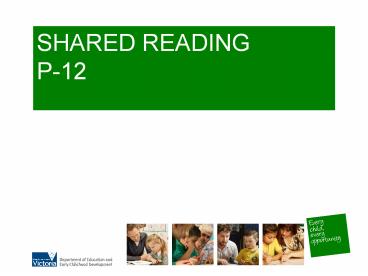SHARED READING - PowerPoint PPT Presentation
1 / 22
Title:
SHARED READING
Description:
SHARED READING P-12 Effective Reading Instruction Teachers must have: Knowledge of reading curriculum Knowledge about learners- What do they do and what do they know ... – PowerPoint PPT presentation
Number of Views:898
Avg rating:3.0/5.0
Title: SHARED READING
1
SHARED READING P-12
2
Effective Reading Instruction
- Teachers must have
- Knowledge of reading curriculum
- Knowledge about learners- What do they do and
what do they know, at home and school? - Knowledge of instructional elements
- High expectations of all students
3
Reading Curriculum
- The reading process
- Comprehension strategies
- Vocabulary affected by world knowledge
- Fluency expression, phrasing, rate
- Decoding
- Response to reading
- Text selection just right texts for Independent
Reading
4
LITERACY ELEMENTS
SPEAKING LISTENING OBSERVATION
ASSESSMENT
- Read Aloud
- Shared Reading
- Guided Reading
- Independent Reading
- Write Aloud
- Shared Writing
- Guided Writing
- Independent Writing
5
GRADUAL RELEASE OF RESPONSIBILITY
Role of the teacher
MODELLING The teacher demonstrates and explains
the literacy focus being taught. This is achieved
by thinking aloud the mental processes and
modelling the reading, writing, speaking and
listening
SHARING The teacher continues to demonstrate the
literacy focus, encouraging students to
contribute ideas and information
GUIDING The teacher provides scaffolds for
students to use the literacy focus. Teacher
provides feedback
APPLYING The teacher offers support and
encouragement when necessary
The student works independently to apply the use
of literacy focus
DEGREE OF CONTROL
Students work with help from the teacher and
peers to practise the use of the literacy focus
Students contribute ideas and begin to practise
the use of the literacy focus in whole class
situations
The student participates by actively attending to
the demonstrations
5
Pearson Gallagher
Role of the student
6
(No Transcript)
7
PAIRED VERBAL FLUENCY
- Work in pairs
- Person A tells Person B everything s/he knows
about the topic for about a minute, while number
two listens carefully. - After the minute is up, Person B tells Person A
everything s/he knows about the topic without
repeating any ideas for 45 seconds - This will be repeated for another two rounds,
with a shorter amount of time allocated to each
round(30 seconds and 15 seconds) - Finally Person B will briefly paraphrase the
conversation with the rest of the group.
8
What is Shared Reading? What is its purpose?
9
SHARED READING Description
- Shared Reading is whole class teaching in a
- supportive environment, using enlarged print and
- high quality text.
- Teachers select text well suited to strategic
- instruction.
- Students and teachers share the task of reading a
- text which might otherwise prove too challenging.
10
SHARED READING Classroom Indicators- Instruction
- Clear instructional focus e.g.
- - Text features and structures -
Problem-solving - - Re-reading and self monitoring - Finding
evidence - Demonstration of how the reading process works
- Teaching for effective use of reading strategies
- High level questioning
- Where appropriate, teachers schedule
opportunities to promote familiarity and
memorisation through repeated readings - Daily instruction 20 minutes
11
SHARED READING Classroom Indicators- Instruction
(Continued)
- Using enlarged text students discover what is
relevant to becoming a reader challenging and
deepening thinking, questioning, self monitoring,
self correcting, sampling, confirming - Using enlarged text to enrich literacy
experiences e.g. varying the way texts are
presented to clearly emphasise enjoyment - Using enlarged text to analyse different text
types and styles
12
SHARED READING Classroom Indicators- Resources
- Many short, enlarged print text selections
- charts short factual and narrative
- text selections e g. science experiment,
newspaper reports, magazines and current affairs
websites - songs, chants, poems and rhymes
- big books all text types
- Enlarged texts and charts well displayed in
easily accessible storage - Interactive whiteboard, data projector overhead
projector
13
(No Transcript)
14
How do we identify an instructional focus?
- Prior observations
- Assessment Tasks
- NAPLAN Data
- VELS
- Teaching for Reading Strategies
15
VELS LEVEL 4 Reading Statement
At Level 4, students read, interpret and respond
to a wide range of literary, everyday and media
texts in print and in multimodal formats. They
analyse these texts and support interpretations
with evidence drawn from the text. They describe
how texts are constructed for particular purposes
and audiences, and identify how sociocultural
values, attitudes and beliefs are presented in
texts. They analyse information, imagery,
characterisation, dialogue, point of view, plot
and setting. They use strategies such as reading
on, using contextual cues, and drawing on
knowledge of text organisation when interpreting
texts containing unfamiliar ideas and information.
16
SHARED READING
- Modelled Session
17
Observation 1
- What was the instructional focus?
- Were the classroom indicators evident?
18
Observation 2
- What was the instructional focus?
- Were the classroom indicators evident?
19
How does it look different across year levels?
20
(No Transcript)
21
Reference
- Breakthrough Fullan Hill and Crevola
- Teaching for Comprehending and Fluency
Fountas and Pinnell - Western Australia First Steps Second Edition
- Effective Literacy Practice 1-4 and 5-8 NZ
Ministry of Education - Victorian Essential Learning Standards DEECD
- Becoming Literate CLAY
- 3 level Guide
- Pearson
- www.education.vic.gov.au/studentlearning/teachingr
esources/english/literacy/default.htm
22
Resources
- Catching onto Comprehension- Pearson
- NAPLAN resources
- AIM resources
- PROBE texts
- Skyrider Shared Reading Kit
- Pearson
- Time for Kids website- http//www.timeforkids.com/
TFK/































